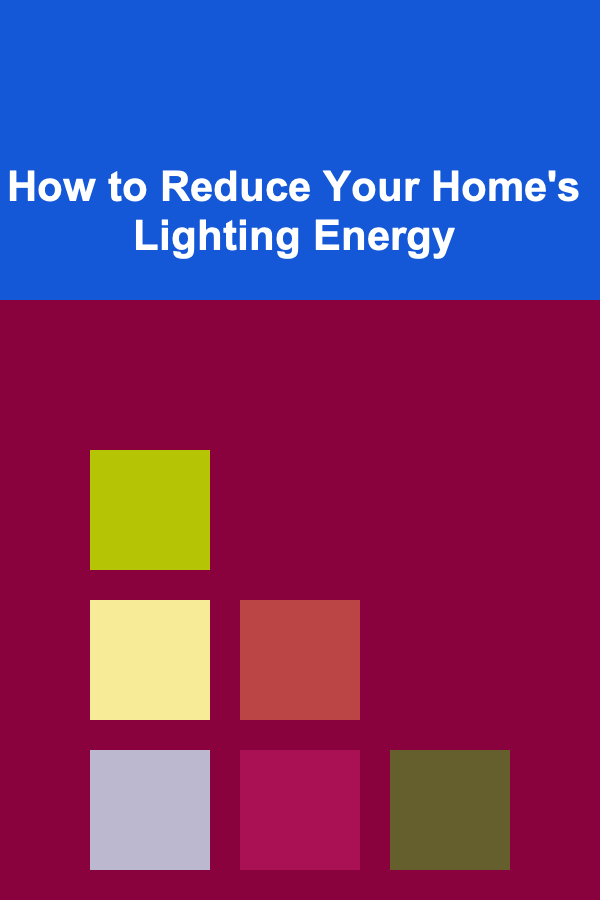
How to Reduce Your Home's Lighting Energy
ebook include PDF & Audio bundle (Micro Guide)
$12.99$5.99
Limited Time Offer! Order within the next:

In today's world, reducing energy consumption is not only a matter of saving money but also a way to contribute to environmental sustainability. The demand for energy-efficient solutions has become increasingly important due to concerns about climate change, resource depletion, and the overall environmental impact of human activities. One of the most effective areas to address energy use in the home is lighting, as it is essential to daily living but also a major contributor to electricity bills. By adopting energy-efficient lighting practices and technologies, homeowners can significantly reduce their energy consumption and carbon footprint.
This article delves into the various strategies and methods for reducing home lighting energy consumption. From choosing energy-efficient bulbs to adjusting lighting habits and incorporating smart technologies, we will explore practical steps that can help homeowners save energy, money, and reduce environmental impact.
Understanding the Impact of Lighting on Energy Consumption
Before delving into the methods of reducing lighting energy, it's important to understand how much of an impact lighting has on overall energy use in homes. Lighting typically accounts for a significant portion of household energy consumption, especially in homes that rely on traditional incandescent bulbs. According to the U.S. Department of Energy, lighting can account for up to 15% of the average household's total energy consumption.
Several factors influence the energy consumption of lighting:
- Type of Bulbs Used: Traditional incandescent bulbs are much less energy-efficient compared to newer technologies such as compact fluorescent lamps (CFLs) and light-emitting diodes (LEDs). The efficiency of a light bulb is directly related to how much electricity is needed to produce the same amount of light.
- Lighting Habits: How often and how long lights are used in a home also significantly affect energy consumption. Leaving lights on unnecessarily, especially in rooms that are not in use, contributes to higher energy usage.
- Lighting Design: The amount of natural light a home receives, the use of reflective surfaces, and the overall design of lighting systems can all play a role in energy consumption. Homes that are poorly lit or lack efficient design may require more artificial lighting to meet daily needs.
- Automation and Control: The use of automated systems, such as timers, motion sensors, and smart lighting, can help optimize energy use by ensuring that lights are only on when necessary.
Understanding these factors allows homeowners to make informed decisions about how to reduce energy consumption in lighting.
Choosing Energy-Efficient Lighting
The most direct way to reduce the energy consumption of lighting in your home is by switching to energy-efficient bulbs. There are several types of energy-efficient lighting options available today, each with varying degrees of energy savings.
1. LED Bulbs
Light-emitting diode (LED) bulbs are by far the most energy-efficient lighting option available on the market. LEDs use up to 85% less energy than traditional incandescent bulbs and can last up to 25 times longer. They are available in a variety of colors and brightness levels, making them suitable for virtually any lighting need.
The efficiency of LED bulbs comes from the fact that they convert more energy into light and less into heat. This is in contrast to incandescent bulbs, which waste much of their energy as heat. Although LED bulbs tend to be more expensive upfront compared to incandescent and CFL bulbs, their long lifespan and low energy consumption make them the most cost-effective option in the long run.
2. CFL Bulbs
Compact fluorescent lamps (CFLs) were once the go-to energy-efficient bulb before LEDs became widely available. CFLs use about 75% less energy than incandescent bulbs and last approximately 10 times longer. However, they are less efficient than LEDs and contain small amounts of mercury, which requires careful disposal when they burn out.
While CFLs are still a good option for reducing energy use, especially in places where LEDs may not be an option or in lower-budget scenarios, they are being gradually phased out in favor of more efficient technologies like LEDs.
3. Halogen Bulbs
Halogen bulbs are a type of incandescent bulb that uses a halogen gas to improve efficiency and lifespan. Although they are more efficient than traditional incandescent bulbs, they are still less energy-efficient than CFLs and LEDs. Halogen bulbs tend to generate more heat and use more energy than LEDs, making them a less ideal choice for reducing energy consumption in the long term.
Halogen bulbs may be appropriate in certain applications, such as accent lighting or in cases where the light output needs to be brighter than what is provided by other types of energy-efficient bulbs.
4. Smart Lighting
Another innovative way to reduce lighting energy consumption is by using smart lighting systems. Smart bulbs and lighting systems can be controlled remotely, and some allow you to adjust brightness levels, change colors, or program lighting schedules. These systems can be integrated into your home automation system, enabling more precise control over when and how your lights are used.
For example, smart bulbs can be programmed to automatically turn off when rooms are not in use, or to dim gradually as natural light increases throughout the day. Motion sensors can be incorporated to ensure that lights only turn on when someone enters a room, preventing unnecessary energy use.
By optimizing lighting control through smart technology, homeowners can reduce the amount of energy consumed without sacrificing convenience or comfort.
Optimizing Lighting Design and Habits
In addition to upgrading to energy-efficient bulbs, there are several strategies to optimize the design and usage of lighting in your home. Small changes in behavior and home design can lead to significant energy savings over time.
1. Maximize Natural Light
One of the easiest ways to reduce lighting energy consumption is to take full advantage of natural light. Design your home to allow as much natural light as possible to enter the living spaces. Use light-colored walls and ceilings to reflect sunlight into the room, and position mirrors strategically to enhance the effect of natural light.
Additionally, consider adding windows or skylights to rooms that tend to be poorly lit, and choose window coverings that allow you to control the amount of natural light entering your space. This can significantly reduce the need for artificial lighting during the day.
2. Use Task Lighting Instead of Overhead Lighting
Instead of relying on overhead lights for general illumination, consider using task lighting for specific activities. Desk lamps, reading lights, and under-cabinet lighting are excellent examples of task lighting that can illuminate specific areas without wasting energy on larger, less efficient light sources.
Task lighting can provide adequate light for activities like reading, cooking, and working at a desk, all while using less energy than overhead lighting. This method also helps create a more comfortable and well-lit environment tailored to your needs.
3. Turn Off Lights When Not in Use
This may seem like an obvious tip, but it is often overlooked. One of the simplest ways to reduce lighting energy consumption is to turn off lights when they are not needed. It is easy to forget to turn off lights in rooms that are unoccupied, but making it a habit to turn off lights as you leave a room can have a noticeable impact on your energy usage.
To further encourage this behavior, consider installing motion sensors in rooms or hallways where lights are frequently left on unnecessarily. These sensors will automatically turn lights off when no motion is detected, ensuring that lights are only used when needed.
4. Adjust Lighting Levels
Not every space in your home needs to be brightly lit at all times. Dim lights when appropriate to reduce energy usage. Using dimmable bulbs or smart lighting systems can help you easily adjust light levels to suit different times of day or activities. For instance, you may not need full illumination in the living room in the evening, and dimmed lights can create a more relaxing atmosphere while saving energy.
5. Use Light Timers
If you're prone to leaving lights on when you're away from home, consider installing light timers. Timers allow you to set lights to automatically turn off after a certain period, reducing the chances of leaving lights on unnecessarily. Some timers also allow you to program lights to turn on and off at specific times, which can be useful for security purposes, making it appear as if someone is home even when you're away.
Implementing Smart Technologies
In addition to using energy-efficient bulbs, smart lighting technologies provide an additional layer of control over energy consumption. Below are some ways smart technologies can reduce lighting energy use:
1. Motion Sensors
Motion sensors are an excellent way to ensure that lights are only on when needed. By detecting movement, motion sensors turn lights on when a person enters a room and turn them off when the room is empty. This ensures that lights are never left on unnecessarily, saving energy and money.
2. Smart Bulbs and Apps
Smart bulbs can be controlled via smartphone apps, allowing you to adjust brightness, color, and even turn lights off when you're away from home. Many smart bulbs also have features such as scheduling, so lights can be automatically turned off at specific times. Smart bulbs use energy-efficient LED technology, further enhancing their cost-effectiveness.
3. Smart Home Integration
Smart lighting can be integrated into a broader home automation system, allowing you to control your lights using voice commands or set them to follow certain routines. For example, lights can be set to automatically dim when you start watching a movie, or to turn off when you leave for work.
Conclusion
Reducing lighting energy consumption in the home is a practical and impactful way to save money, reduce energy use, and contribute to a more sustainable environment. By making informed decisions about lighting choices, optimizing lighting design and habits, and incorporating smart technologies, homeowners can significantly decrease their energy consumption without sacrificing comfort or convenience.
The transition to energy-efficient lighting, such as LED bulbs, and the use of smart home technologies, can have a lasting impact on both your electricity bills and your carbon footprint. By taking steps to reduce lighting energy use, we can all play a part in creating a more energy-efficient and sustainable future.

How to Clean and Maintain Your Home's Fireplace for Safe Use
Read More
How to Organize Your Music and Movie Collections
Read More
How To Understand the Long-Term Benefits of Frugal Habits
Read More
How to Use Podcasts for Thought Leadership
Read More
How to Build a Crisis-Resistant Portfolio
Read More
How to Read a Company's Financial Report
Read MoreOther Products

How to Clean and Maintain Your Home's Fireplace for Safe Use
Read More
How to Organize Your Music and Movie Collections
Read More
How To Understand the Long-Term Benefits of Frugal Habits
Read More
How to Use Podcasts for Thought Leadership
Read More
How to Build a Crisis-Resistant Portfolio
Read More